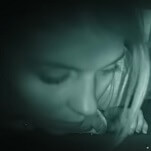Each week, Big Issues focuses on a newly released comic book of significance. This week, it’s Clean Room #2. Written by Gail Simone (Batgirl, Red Sonja) with art by Jon Davis-Hunt (2000 AD, Judge Dredd Megazine), the issue marks a significant improvement for the series by adjusting the pace of the narrative and spending more time on tension and character relationships. (Note: This review reveals major plot points.)
Earlier this week, The Hollywood Reporter announced that the new Vertigo Comics series Unfollow is in development as a TV series at ABC Studios, which shouldn’t come as much of a surprise to anyone who has been reading the Vertigo debuts this fall. The imprint is just past the halfway mark of its three-month initiative launching a new title every week, and nearly all of the seven new first issues released at this point have read like comic pitches for TV pilots. With the exception of The Twilight Children, a surreal miniseries by master cartoonists Gilbert Hernandez and Darwyn Cooke, the Vertigo debuts have tried to pack a pilot’s worth of material into 20-page comics, resulting in some very rushed, overstuffed stories.
This week’s Red Thorn #1 is the latest Vertigo series premiere to suffer from this problem, and the consistent underperformance of these first issues hasn’t done much to build confidence in the struggling imprint. Hope is not lost, though; just as some TV shows improve on lackluster pilots, there’s still an opportunity for these Vertigo creative teams to make positive changes after laying the groundwork of their first issues. That’s what writer Gail Simone and artist Jon Davis-Hunt accomplish with Clean Room #2, a chapter that considerably slows down the pacing after a first issue that was jam-packed with information, making for a more compelling, atmospheric read.
Clean Room follows journalist Chloe Tona Pierce as she investigates a Scientology-esque “self-actualizing” organization that she believes had a direct involvement in her fiancé’s suicide, and the second issue has her sitting down with the mysterious founder of the group, Astrid Mueller, to get some answers about what’s going on. The first issue hastily moved from Astrid’s life-altering childhood trauma to Chloe’s present-day suicide attempt, incomplete recovery, and the start of her investigation, relying on narration to deliver hefty chunks of exposition detailing the backstory of Chloe’s relationship with her husband and the woman that may have had a hand in his death. Simone had to cover a lot of plot to reach the point where Chloe and Astrid meet face-to-face at the end of the first issue, but now that the main characters have met, the script relaxes and places a great emphasis on building their personal dynamic.
Astrid and Chloe’s meeting takes up the majority of this issue, and the quality of the storytelling improves considerably when Simone and Davis-Hunt give themselves space to fully explore the personalities of these two women and how they clash. Chloe’s aggressive need for answers doesn’t sit well with Astrid, who is clearly irritated by Chloe’s forceful questioning but doesn’t let herself get worked up, and the tension between the two women grows as they spend more time together. One small but especially effective tension-building moment comes after Chloe tells Astrid about her fiancé’s suicide; Astrid pauses to take a sip of tea before her one-word response, “Interesting,” and the two silent close-up panels give the action extra importance by giving it prominent focus.
Finally aware of Chloe’s reason for meeting her, Astrid changes her strategy in those two silent panels, and when she speaks again, it’s to throw Chloe off her guard. She starts by asking Chloe how selfish her grief is, and if she’s infuriated that she’s not allowed to be angry at her late fiancé. Chloe’s resolve quickly begins to shatter, a mental shift represented by a crumbling panel when she thinks about the people that speak more highly of Philip after his death, and Astrid’s probing questions only make matters worse for Chloe. The more personal the questions, the less equipped Chloe is to deal with them, and when Astrid starts asking Chloe about missing her fiancé’s erection and the last time she masturbated, Chloe has a complete mental break.
Davis-Hunt’s full-page spread of Chloe being berated by a demonic hallucination hits with incredible impact after the quiet tension that precedes it, and the artist has a strong talent for horrific monster design. With sharp teeth, spikes, and barbs, multiple tongues that reach out like tentacles, and insect-like wings that protrude from the bumpy pale flesh on its back, the hallucination is pure nightmare fuel, and the coloring is particularly interesting. Pink, a color traditionally associated with femininity, is attached to the sinister elements of Simone’s story. Astrid’s nails and furniture are pink, as are the flowers painted on her teacups, and the monster in Chloe’s mind has neon pink glowing from underneath its skin, which is a blend of pinks and purples. The book’s logo is pink and it’s the accent color on Jenny Frison’s sleek, stylish covers, making pink an essential part of this book’s visual identity, but not in a way it’s conventionally used.
The big development in Clean Room #2 is the revelation of what the Clean Room actually is, but there’s still plenty of mystery surrounding Astrid Mueller’s primary tool for helping people achieve self-actualization. The all-white room appears to be some type of holographic imaging facility that allows Mueller to explore the deepest, darkest secrets of her patients by projecting their memories, but Mueller’s therapy has deadly side effects. The homeless man who told Chloe about the Clean Room in the first issue is found murdered in the second issue’s opening sequence, his body broken and tied in a gruesome knot, left on the floor of a room with no traces of evidence. There’s a connection between the clean room the two police detectives enter and the Clean Room introduced to Chloe, but it has yet to be established.
Chloe sits through an unnerving Clean Room session with a man who can’t sleep because he’s haunted by his memories of blinding and killing two child siblings, and she’s disgusted when Astrid seemingly lets the man free after learning his terrible past deeds. She might feel better knowing that the Clean Room also makes a person’s greatest fears manifest to make them pay for their sins, but she doesn’t know that yet. That final bit of information is revealed in the issue’s frightening final scene, which ends the chapter on an unsettling note while also incorporating the dark humor that is such a big part of Simone’s appeal.
When Dwight Fennister was a boy, his mother used to tell him that there were white monkeys hiding under his bed waiting to bite off his penis if he ever touched it, and when he gets back home after his visit to the Clean Room, the white monkeys are there to greet him. (And not just regular monkeys, but monkeys with spider legs to make them extra creepy.) As the swarm of monkeys pin Dwight to his bed, the largest one assures him, “Don’t worry, WE KNOW YOU TOUCHED IT,” and it’s the kind of pitch-black punch line that reads as distinctly Simone. The writer’s voice shines through when she’s not rushing through the narrative, and if Clean Room maintains this second issue’s upswing in quality, it could end up being the great new ongoing Vertigo needs.








































